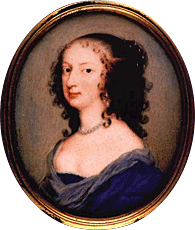


By Ron Cooley, et al.
Reprinted with permission from As One Phoenix.
I would rather die in the adventure of noble achievements than
live in obscure and sluggish security.
In 1623
in Colchester, Essex, Sir Thomas Lucas and his wife Elizabeth had their
eighth child, a daughter whom they named Margaret. The Lucas children were
indulged, but they were also encouraged to lead kind and virtuous lives.
All were taught by an elderly gentlewoman, who imparted only the rudiments
of reading and writing. Margaret and her sisters also learned needle-work,
singing, dancing, and were taught to play the lute and virginal (an early
form of the spinet). Margaret seems to have adored every member of her
family, and she was loved and cherished in return. In this secure environment
Margaret developed, at a young age, an overwhelming desire to be known
as a wit and a beauty. Her first efforts at writing were what she called
her baby books. She wrote sixteen of these books, the shortest of which
was two or three quires of paper [50-75 pages]. The more she wrote the
stronger became her ambition to excel in literature.
The members
of Margaret's family were devoted Royalists. In 1640, when she was seventeen,
the civil war broke out in England. Margaret Lucas fled to Oxford with
her sisters and their husbands, where Charles I and his court were in exile,
and Margaret became a maid-of-honour to Queen Henrietta Maria. But after
the royalist forces were defeated at Marston Moor in 1644 the Queen and
her court fled further into exile in France. This flight was traumatic
for Margaret as it was her first total separation from her family; moreover
it resonates with a recurring romance motif in her books, where a lady
flees to unknown lands and endures many mishaps.
In France Margaret
met William Cavendish, the first Duke of Newcastle, and the couple married
in 1645. They lived in comparative poverty during the Interregnum, first
in Paris then Antwerp. During this time Margaret received informal lessons
in science and philosophy from both her husband and his brother Sir Charles
Cavendish.
Margaret Cavendish
returned to England, for a time in November of 1651. During that year she
spent her days and nights writing her first book, a collection of poems
entitled Poems and Fancies. The book caused a sensation, provoking bot
applause and derision. Many readers appreciated her originality while others
criticized her spelling, grammar, and writing style. In later editions
of her works Margaret refused to apologize for her spelling or grammar,
affirming that it was "against nature for a woman to spell right" and that
she was "unable to understand grammar and the little she knew was enough
to make her renounce it" (Grant 112). She did, however, apologize for "her
own audacity in writing at all, being a woman." (Jones 1). Cavendish was
also criticized for her weak narrative style and poor characterization
in her fiction. Her plays were censured for a lack of unity. Her critics
thought her "mad, conceited, and ridiculous" (Jones 1), and ridiculed both
her writing and the outrageous and original costumes she wore in public.
Margaret Cavendish
was a woman of firsts, and especially displayed brilliance and freedom
of thought in works of science fiction like The Blazing World. Her enthusiasm
for science was reflected in books and poems where she focuses on ideas
such as the smallness of an atom and imagines how there might be "other
worlds within this world . . . [a] world in an ear-ring worn by some lady
quite unconscious of her responsibility" (Grant, 117). She was the first
woman in England who wrote mainly for publication. Despite staunchly traditional
politics, and a posture of exaggerated deference towards her husband, she
was capable of bold feminist statements: "Women live like bats or owls,
labour like beasts, and die like worms" (Jones 1). Criticism of Margaret
Cavendish outweighed praise and yet she continued to write. She published
twenty-two works during her lifetime, and her modern reputation is of a
truly remarkable woman. Virginia Woolf, in an essay about the Duchess,
captures the ambivalence of Cavendish's readers: "though her philosophies
are futile, and her plays intolerable, and her verses mainly dull, the
vast bulk of the Duchess is leavened by a vein of authentic fire"(The Common
Reader 77). Margaret Cavendish, Duchess of Newcastle died suddenly on 15
December 1673 at the age of fifty.
Bibliography
Reprinted, with express written permission, from
Cooley, Ron and Brecken Hancock, Kristen Kenyon, Annette
Lapointe, Joan Morrison, Barbara Palmer, and Lawrene Toews.
As One Phoenix: Four Seventeenth Century Women Poets.
University of Saskatchewan, 1998.
|

